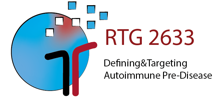Estelle Bergmann
Identification of the major epitope of the BP180 ectodomain recognized by serum IgA autoantibodies of patients with pemphigoid diseases –IgA autoantibodies as prognostic marker?
Subepidermal blistering autoimmune dermatoses belong to a group of rare autoimmune skin diseases in which autoantibodies target structural proteins such as BP180 (type XVII collagen), BP230, laminin 332, α6β4-integrin, and type VII collagen in the dermo-epidermal junction (DEJ) region. This group of blistering autoimmune dermatoses (BAID) include bullous pemphigoid (BP), mucous membrane pemphigoid (MMP) and linear IgA disease (LAD). In all three diseases, previous work had shown that patient sera had IgA autoantibodies against the BP180 ectodomain. Also, an association of antibody subclass and age was found. Predominantly IgA autoantibodies were found in younger patients and autoantibodies of the IgG type in older patients, which raises the question whether early occurrence of IgA autoantibodies in subepidermal BAID is significant for disease development. However, in the detection of autoantibodies against the BP180 ectodomain, there are no commercial testing systems or assays available. Consequently, the testing for autoantibodies against the BP180 ectodomain is only done in specialized laboratories through immunoblotting.
The aim of the study is to identify the major epitopes on the BP180 ectodomain recognized by IgA autoantibodies in the different diseases (LAD, BP and MMP) by the development of a standardized test-system using recombinant proteins of BP180. By adjusting the sensitivity and specificity of these tests the prospective goal is to allow for the possibility of replacing the immunoblot used in routine diagnostics with a widely available assay to screen for IgA autoantibodies at early stages of disease development. In the process we also hope to gain insights of early IgA mediated response in subepidermal BAID.

- People
- Doctoral Candidates
- Merabell Adem
- Katja Adriany
- Farbod Bahreini
- Estelle Bergmann
- Swayanka Biswas
- Jana Buhre
- David De Luca Laredo
- Kaan Ersoy
- Ferdinand Gebauer
- Sen Guo
- Veronika Hartmann
- Michelle Hein
- Luise Janusch
- Maj Jäpel
- Anna Knauer
- Valentin Kneitz
- Maximilian Lahmer
- Wing Yu Lee
- Daniel Mehlberg
- Sahar Mehrabani
- Afsaneh Mehrpouyan
- Sadegh Mousavi
- Milica Novovic
- Justus Ohmes
- Bianca Opelka
- Colin Osterloh
- Cristian Papara
- Tina Rastegar Lari
- Rochi Saurabh
- Alessia Maria Sbaraglia
- Jovan Schanzenbacher
- Mareile Schlotfeldt
- Carolin Schmidt
- Solveig Lea Schmidt
- Leon Schmidt-Jiménez
- Nora Schoell
- Salomini Sinnathurai
- Sarah Stenger
- Chiara Walczyk
- Nele Wellbrock
- Julia Wimmer-Gross
- Natalia Zappe
- Jianrui Zheng
- Luca Zillikens
- Carla Zünkeler
- Principal Investigators
- Associated Scientists
- Administration
- Doctoral Candidates




